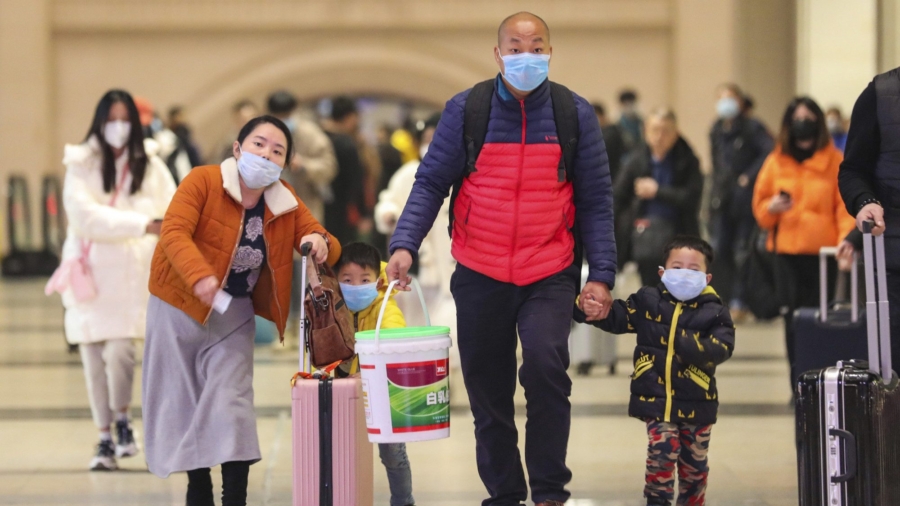China said on Jan. 22 that 440 people have now contracted a new virus that first appeared in Wuhan and has killed nine people, amid fears the respiratory disease could become a global epidemic.
Li Bin, vice minister of China’s National Health Commission, told reporters the figures were accurate as of midnight Tuesday, and that all nine deaths from coronavirus had been in Hubei province, from where the World Health Organization (WHO) was first notified of the virus on Dec. 31, 2019.
A further 2,197 people who came into contact with those already infected were isolated, Li Bin said, and that 765 of those have been released from observation. China on Jan. 20 admitted that the disease could be transmitted human to human, raising concerns that the illness has already spread widely across the country.
It is estimated that the virus has already reached 20 mainland cities other than Wuhan, according to a study by the University of Hong Kong (HKU).
“Recently there has been a big change in the number of cases, which is related to our deepening understanding of the disease, improving diagnostic methods, and optimising the distribution of diagnostic kits,” Li said.
He said the new strain of coronavirus is mainly spread through respiratory transmission, warning that China must now urgently work to prevent and control the spread of the disease.
“The virus may mutate, and there is a risk of further spread of the virus,” he said, according to The Guardian.
His comments came as the WHO on Wednesday scheduled an emergency meeting to discuss the virus and whether to declare a public health emergency of international concern.
The surge in cases of coronavirus also followed news that the U.S. had become the fifth country outside of China—and the first outside Asia—to confirm a case of infection.
The patient, who is in his 30s, is understood to have travelled on Jan. 15 to Seattle from Wuhan, where the outbreak originated. He remains in isolation at Providence Regional Medical Center in Everett, Washington.
The Centers for Disease Control and Prevention (CDC) has since upgraded its precaution levels for traveling to China from level one to level two on a three-tier scale, warning travelers to exercise “enhanced precautions.”
Li said Japan, South Korea, and Taiwan had also confirmed one case each of the virus and Thailand four. An Australian man has also been placed in isolation after returning from central China with flu-like symptoms.
Concerned about a global outbreak similar to SARS (severe acute respiratory syndrome)—another coronavirus that spread from China to more than a dozen countries in 2002-2003—numerous nations have adopted screening measures for travelers from China, especially those arriving from Wuhan.

In this Tuesday, Jan. 21, 2020, photo, a worker monitors display screens for infrared thermometers as they check travelers at Hankou Railway Station in Wuhan in southern China’s Hubei province. (Chinatopix via AP)Concerns have been heightened as millions of Chinese are expected to travel to their hometowns for the Lunar New Year holiday, which falls on Jan. 25 this year. Many return home for festivities or travel abroad for vacation, with official data showing that roughly 3 billion trips take place every year during the new year period. Wuhan has a population of 11 million people.
Coronaviruses are a family of viruses that cause respiratory disease ranging from the common cold to SARS.
The most common symptom of the virus is a high fever. However, other symptoms include breathlessness, a sore throat, and a cough. Severe cases of infection can cause pneumonia, severe acute respiratory syndrome, kidney failure, and even death, according to the WHO.
As the virus—also known as 2019-nCoV—has an incubation period of seven days, symptoms may not immediately be noticeable.
Chinese authorities believe the outbreak is linked to a fresh food market in Wuhan which sold seafood and wild animals. The market, which was linked to all SARS cases seen in Wuhan in 2003, has been closed since Jan. 1.
Gao Fu, the director of China’s Center for Disease Control and Prevention, said that the virus likely originated from wild animals and mutated after it transferred to humans and became contagious among humans.
He added that Chinese officials are working on the assumption that the outbreak resulted from human exposure to wild animals that were being traded illegally in the Wuhan market.
The WHO has urged people to avoid “unprotected” contact with live animals and avoid close contact with those with cold or flu-like symptoms, as well as cook meat and eggs thoroughly.
Reuters and the Associated Press contributed to this report.
From The Epoch Times

